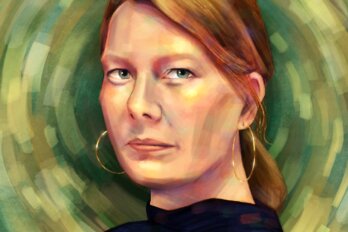Robertson Davies—a man with a considerable talent for creative insult—reserved one of his best for the writer, painter, and critic Wyndham Lewis. In a dismissal so sublime as to test the limits of intelligibility, he said that Self Condemned, Lewis’s recently reissued novel about Canada, read “as though it had been written in lemon juice, with a rusty nail, on a piece of tin.”
If his point was that Lewis was bitter, the evidence is certainly on his side. Hester Harding, the heroine of Self Condemned, is probably the only character in literature to kill herself out of sheer hatred for Canada. In the suicide note she leaves her husband, a disillusioned English historian, she says, “I loathe this country so much, where I can see you burying yourself. I cannot leave you physically—go away from you back to England. I can only go out of the world.” She is not alone in finding life in Canada loathsome. Professor Harding calls it “an outlandish culture-less world”—a “tenth-rate alternative to what had been his backgrounds.” The novel focuses its vitriol on Momaco, Lewis’s code name for World War II Toronto. “Momaco was so ugly, and so devoid of all character as of any trace of charm,” he writes, “that it was disagreeable to walk about in. It was as if the elegance and charm of Montreal had been attributed to the seductions of the Fiend by the puritan founders of Momaco.”
This fall marks the seventieth anniversary of Wyndham Lewis’s arrival in Toronto and the beginning of the experiences upon which Self Condemned was based. Lewis left England with his wife to flee the coming war and seek opportunities for work, sailing from Southampton on September 2, 1939—the day after Germany invaded Poland. Pursued across the Atlantic by U-boats, he arrived in Quebec City, stopped briefly in Toronto, and proceeded—as was his plan—to New York. Unsuccessful there, and harassed by visa troubles, he returned reluctantly to Toronto in the fall of 1940 and remained in Canada until the end of the war, painting portraits to support himself. He was able to do so without further visa complications because he held a Canadian passport. Wyndham Lewis, the disgruntled English exile and author of the venomously anti-Canadian Self Condemned, was Canadian by birth.
Though Lewis’s name means little in this country today, to his contemporaries it was infamous. The announcement of an article forthcoming from his pen was enough to make Virginia Woolf panic. “Now I know by reason and instinct,” she wrote in her diary in 1934, “that this is an attack; that I am publicly demolished; nothing is left of me in Oxford and Cambridge and places where the young read Wyndham Lewis.” She had reason for her alarm. In the book in which the article on Woolf eventually appeared, Lewis included a chapter on Ernest Hemingway called “The ‘Dumb Ox.’” On first reading it in the Shakespeare and Company bookstore in Paris, Hemingway became so enraged that he punched out a vase of tulips. Among the victims of the resulting spill, which cost Hemingway several thousand francs, was a drowned copy of Mrs. Dalloway.
In Time and Western Man, a sweeping work of social philosophy, Lewis described James Joyce’s Ulysses as “a suffocating moeotic expanse of objects” that would remain, in the history of literature, “eternally cathartic, a monument like a record diarrhoea.” No kinder to his friends than to his enemies, he called Ezra Pound “a person without a trace of originality,” and accused T. S. Eliot of “dogmatic insincerity.” Revenge against Lewis took various forms. Hemingway delivered a mighty blow in A Moveable Feast, describing him as possessing the eyes “of an unsuccessful rapist.” In Finnegans Wake, Joyce parodied Lewis as the author of “Spice and Westend Woman.” Conversely, Pound called Lewis “the only English writer who can be compared to Dostoevsky.” Eliot called him “the most distinguished living novelist.”
Percy Wyndham Lewis was born in Amherst, Nova Scotia, in 1882. According to a self-propagated myth apparently designed to deny any physical attachment to Canadian soil, this auspicious event took place on a ship in the harbour. His mother was English and his father an American Civil War hero. According to Lewis’s questionable memory, his early childhood was spent watching his mother paint landscapes while his father composed adventure romances. In fact, it was spent in a series of briefly inhabited hotels in Maritime outports. Appropriately, given his son’s later championing of bacchanalian Montreal, Lewis’s father was an itinerant salesman for a Montreal-based wine business. His mother occupied her time fussing over her sickly son and writing letters home to England—which is where, when Lewis was six, his parents moved and eventually separated.
One could forgive Lewis if he seldom thought of Canada in the period between his arrival in England and the start of World War I—he was busy. After studying at the Rugby School and the Slade School of Fine Art, he developed a reputation as the most advanced painter in England, with an abstract style incorporating elements of futurist and cubist design. Immediately before the war, he established vorticism, the only avant-garde movement in modernist English art. He also published Blast, his gigantic and famously pink periodical with poems by Eliot and Pound, and manifestos, reviews, and a play by himself.
The Great War put an end to vorticism, however, and reintroduced Lewis to his native land. Serving as a bombardier at the Somme, he later sought an escape from active duty by pursuing work as a war artist. He was recruited by the Canadian War Memorials Fund, which was managed by another Maritimer well established in England, Lord Beaverbrook. The commission took Lewis to Vimy Ridge, where he was not only reintroduced to his countrymen, but also afforded the opportunity of witnessing first-hand what is often regarded as the birth of the Canadian nation. In the massive canvas he produced, A Canadian Gun-Pit (1918), a group of soldiers differentiated by race and language are menaced on all sides, engaged in futile, mechanical routines, and yet—in stark contrast to Lewis’s later depictions of Canadian society—they present an image of coordinated action.
In the interwar period, he curtailed his artistic output and reinvented himself as a social critic. His mission in this new role was to analyze the circumstances that had led to the war and determine how best to prevent another. Through a chain of events whose logic only Lewis could fathom, this culminated in his publishing the first book in English on Hitler. Lewis’s works of the ’20s argued that advertising, the press, and propaganda had conspired to produce a servile and brainwashed generation, and then had led it effortlessly to war. Lewis’s Hitler—published in 1931, two years before the Nazis came to power—argued that Hitler at least did not hide his lust for power behind the facade of free choice. And with reasoning that truly bends the mind, Lewis argued that Germany under fascism would be less likely to head to war. In a chapter titled “Adolf Hitler a Man of Peace,” he proposed that while the democratic states were bent on setting nations against one another, the Nazis’ emphasis on race would serve to “draw people together, rather than thrust them apart”—or “at least people of the same race,” as he fatally concluded.
For most of the following decade—the period in which W. H. Auden memorialized him as “that lonely old Volcano of the Right”—Lewis continued to support fascism. Shortly before the outbreak of World War II, however, he finally realized his mistake and published his follow-up to Hitler, called The Hitler Cult, in which he confessed himself “badly taken in” and proceeded to offer a series of belated denunciations. Facing the prospect of a long war against an enemy he had long supported, Lewis decided circumstances would be better on the other side of the Atlantic.
While he was making his crossing, a U-boat sank another passenger ship, the SS Athenia. His own, also under pursuit, was forced to zigzag toward Greenland. Such were the conditions in which Lewis effected his inglorious return to Canada: having first destroyed his reputation with the publication of Hitler, he was then chased out of Europe by Hitler’s submarines.
Lewis settled in the Tudor Hotel on Toronto’s Sherbourne Street in the fall of 1940. From this address, he sent forth a voluminous correspondence in which contempt for Canada provided the dominant motif.
To the American literary critic John Crowe Ransom, Lewis described Toronto as an “ice box.” To Edmund Wilson, he added a memorable epithet, calling it a “sanctimonious ice box.” To his publisher, it was “this blasted ice-box”; to the painter Augustus John, “this sanctimonious bush-babylon.” Departing from the formula but not the sentiment, he told Louis MacNeice that Canada was “the most parochial nationette on earth.” He complained to another friend that Canada possessed “probably the dumbest English-speaking population anywhere,” which “reads less per capita than any other known civilized population.”
On many counts, it is difficult to sympathize with Lewis. His charges of neglect in frozen and philistine Toronto are belied, for example, by the fact that he was befriended by A. Y. Jackson and offered air time on CBC. He also managed to earn three times the average Canadian wartime salary from his portrait painting and other work. But on other counts, he had a point. A contemporary Torontonian deposited into the puritanical city of the 1940s would share at least some of Lewis’s dismay. As he put it in Self Condemned, “There are Ten Commandments in Momaco, as in no other city in the world.” In one of his first letters from Sherbourne Street, he wrote, “On the whole I prefer Montreal as a city—if only because there one does not have to sign so many slips of paper in order to buy a bottle of Scotch.”
His most serious and sustained complaint, however, was also his most surprising. He charged Canada—today so proudly multicultural—with racism and intolerance, and spent much of his time here drafting America and Cosmic Man, a book in which he argues for the global importance of the peacefully multiracial American society of the 1940s. Walking through the streets of the marvellously diverse “rootless Elysium” of wartime New York, he said, “You are at last in the world, instead of just in a nation.” This microcosm presented what he regarded as “a kind of advance copy of what an eventual world society would be.”
If contemporary Toronto seems like a fulfillment of Lewis’s prophecy, in America and Cosmic Man it functioned as his counter-example. He condemned the “impassable race-barrier separating the English Canadians and the French Canadians,” and blasted the marginalization of Catholics and those with “Indian blood” at the hands of “the latter-day Puritans of this isolated and backward country.” In an article published in Saturday Night, he attacked “Anglosaxon Canada” for its “pride in being repellent, rather than attractive, to the stranger within-the-gate.” With the looming tide of emigration from war-ravaged Europe, he said, Canada’s snooty, intolerant attitude would cause it to miss its opportunity of becoming a properly “cosmic” society.
It is not entirely by accident that Canadian society eventually developed along lines that would have pleased Lewis. Though his time in Canada was comparatively brief and absolutely miserable, he nonetheless exerted a significant impact on the generation of thinkers who shed Canada’s reputation as a cultural backwater. The most notable of them was Marshall McLuhan.
Lewis’s stay in Toronto was brought to an abrupt and appropriate end in February 1943, when the Tudor Hotel burned to the ground in the dead of winter. That same month, he was offered a teaching position at Assumption College in Windsor. It was a lucky turn on several counts: he was closer to his beloved United States, enjoyed his teaching, and found a number of interesting commissions—for example, to paint the mother of a future prime minister, chillingly depicted in Portrait of Mrs. Paul Martin. Most important, however, was the fact that McLuhan’s mother was living in Windsor, and she promptly notified her son of Lewis’s arrival.
In the ’30s, McLuhan had been one of those Cambridge-based Lewis devotees mentioned by Virginia Woolf; his analysis of media and society had its origin in the books by Lewis he encountered there. “Good heavens,” he told novelist Sheila Watson in a later interview, “that’s where I got it! Lewis was the person who showed me that the man-made environment was a teaching machine—a programmed teaching machine.”
In Windsor, the two became friends. Lewis drew McLuhan’s portrait; McLuhan helped Lewis with his research and found him sitters for paintings. As was bound to happen, they also quarrelled. When McLuhan cheekily asked Lewis to sign his copy of Hitler, Lewis confiscated it, tore it to pieces, and deposited the remains in an incinerator.
When McLuhan read America and Cosmic Man, he said it had the impact of “an H-bomb let off in the desert.” He derived his famous concept of the “global village” from the passage where Lewis says, “The earth has become one big village, with telephones laid on from one end to the other, and air transport, both speedy and safe.” McLuhan’s “global village,” embodied in the microcosmic Canadian cities of the present day, comes from a book that specifically attacks Canadian intolerance.
In the first of his two autobiographies, Blasting and Bombardiering, Lewis said of his modernist cohort, “We are the first men of a Future that has not materialized. We belong to a ‘great age’ that has not ‘come off.’” Canadian society, as if to spite him, realized the utopian future outlined in America and Cosmic Man. The Canadian arts, however, have been mostly content to let his statement stand. After a brief enthusiasm for his work in the 1960s—led by Sheila Watson, who wrote her dissertation on him—one has had to look with a microscope to discover traces of his influence.
Up until this year, if one were to have engaged in the mildly treasonous act of reading Self Condemned, it would most likely have been in the volume edited by Rowland Smith. A former chairman of the English department at Dalhousie, Smith was the father of the writer Russell Smith. The latter admits with some embarrassment never to have made it through one of Lewis’s novels. But he absorbed Lewis’s radiance, as it were, through the atmosphere. “It was his influence on my father that was the most profound influence on me,” he told me. “My house, as I grew up, was crammed with Lewis books and pictures, and I used to read, as a teenager, over and over again the manifestos in Blast. I loved the misanthropic energy of them.”
Lewis’s presence is also discernible in the splenetic protagonist of Damian Tarnopolsky’s 2009 novel Goya’s Dog. The perspective of Edward Dacres, an English painter stranded in World War II Toronto, whose experience is loosely based on that of Lewis, is neatly summed up when he imagines what a particular city block “would look like through a bomb sight.” Tarnopolsky, who moved to Toronto from England in his teens, was drawn to Lewis for his story rather than from any particular admiration for his work. Self Condemned, which he found “incredibly flat and depressing to read,” inspired him to aim for the opposite effect in his own book. “I suppose,” he told me, “that’s a kind of influence.”
In the academic world, some of Lewis’s infamy survives. Allan Pero, a professor at the University of Western Ontario who wrote the introduction for the recent reissue of Self Condemned, has suffered its refractions. “I have had people assume, when told I was working on Lewis, that I must be a misogynistic, racist homophobe with far right-wing sympathies,” he told me, adding that “not one of these assumptions is remotely true.” The situation, however, is slowly changing: “I think scholars are more interested these days in wrestling with the scope and complexity of Lewis’s work and ideas—and generally more appreciative of the wit and verve that informs much of his best work.” Pero hopes his new edition of Self Condemned—a novel he says provides “a fresh, outsider’s view” of Toronto and Canada—will help Lewis finally discover his Canadian audience.
In Jorge Luis Borges’ short story “The Approach to Al-Mu’tasim,” a disaffected student discovers unexpected tenderness in the conversation of a slum dweller. “He knows the vile man conversing with him is incapable of this momentaneous decorum,” the narrator says. “From this fact he concludes that the other, for the moment, is the reflection of a friend, or of a friend of a friend.”
Seventy years after his ill-fated arrival in Toronto, the influence of Wyndham Lewis on Canadian arts and letters today is best understood as a demonic inversion of Borges’ story. Sometimes one comes across a phrase or a brush stroke in the work of a Canadian artist that is incongruous in its loathsome daring or unsavoury gusto—some anomalous element whose momentaneous lack of decorum exceeds the range of possibilities usually encountered in our writers and painters. Unable to explain the stylistic abnormality as autochthonous, one is forced in such circumstances to conjecture a remote influence.
There—multiply reflected, lurking in the distance, his vile energy at several removes, the fiend of a fiend—stands Wyndham Lewis.
This appeared in the October 2010 issue.





